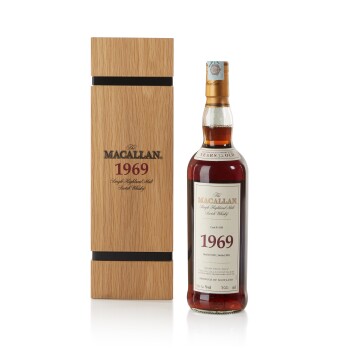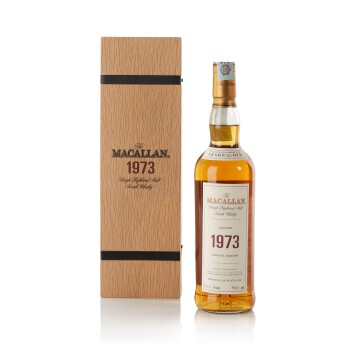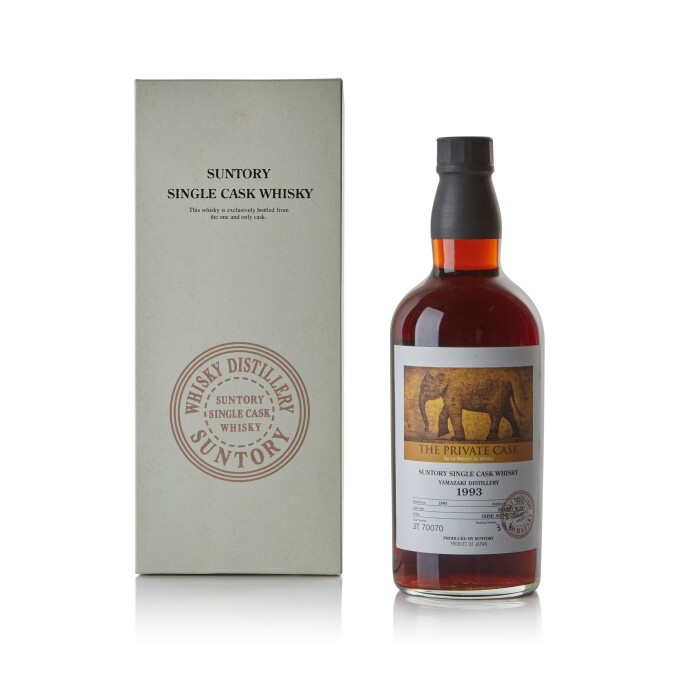F rom The Macallan’s most sought-after releases to The Prima & Ultima Collection, as well as an array of rare Italian import Scotch including the highly acclaimed Samaroli Laphroaig 1970, Sotheby’s Distilled sale features some of the very rarest whiskies to be offered at auction. Comprising 267 lots this is Sotheby’s largest online-only spirits auction to date.
Featured Highlights
The Macallan Fine & Rare Timeline
The Macallan Fine & Rare is considered to be the pinnacle of whisky collections. The highest value ever achieved for a bottle of whisky at auction is the Macallan Fine & Rare 1926, which sold at Sotheby’s last year for £1.5million. This collection containing bottles from 1940-1976 is in exceptional condition and the ultimate trophy for any whisky enthusiast.
- 1940
- 1945
- 1946
- 1948
- 1949
- 1950
- 1951
- 1952
- 1954
- 1955
- 1958
- 1959
- 1965
- 1966
- 1966
- 1967
- 1968
- 1969
- 1970
- 1971
- 1972
- 1973
- 1974
- 1975
- 1976
-
 Lot 41
Lot 41 -
 Lot 40
Lot 40 -
 Lot 39
Lot 39 -
 Lot 38
Lot 38 -
 Lot 36
Lot 36 -
 Lot 35
Lot 35 -
 Lot 34
Lot 34 -
 Lot 33
Lot 33 -
 Lot 31
Lot 31 -
 Lot 30
Lot 30 -
 Lot 29
Lot 29 -
 Lot 28
Lot 28 -
 Lot 27
Lot 27 -
 Lot 24
Lot 24 -
 Lot 26
Lot 26 -
 Lot 22
Lot 22 -
 Lot 21
Lot 21 -
 Lot 19
Lot 19 -
 Lot 17
Lot 17 -
 Lot 15
Lot 15 -
 Lot 11
Lot 11 -
 Lot 9
Lot 9 -
 Lot 8
Lot 8 -
 Lot 6
Lot 6 -
 Lot 2
Lot 2

Prima & Ultima is a new collectable series of rare single vintage malt whiskies, each drawn from a tiny number of casks with their own story to tell, and bottled by the distilleries’ owner, Diageo.
Sotheby’s are particularly pleased to mark our first partnership with Diageo for charity to benefit Wateraid. WaterAid and Diageo have worked together for more than a decade to advance access to water, sanitation and hygiene (WASH) across Africa and more recently in southeast Asia. Benefitting the lives of more than 80,000 people, projects have been undertaken both in Diageo’s own supply chains and beyond those four walls.
Japanese Whisky
Previously considered to fall within the “World Whisky” category by many whisky writers, Japanese whisky today is very much a category of its own, and in 2019 we celebrated its centenary.
While the opening of Shinjiro Torii’s first distillery (now known as Yamazaki) between Osaka and Kyoto in 1923 is largely considered the birthplace of Japanese Whisky, it was actually Akashi producer White Oak Distillery in Eigashima, near Kobe, that became the first licensed Japanese Whisky Distillery in 1919.
Estimate: 5,000 - 6,000 GBP
Japan’s love affair with whisky originally began back in 1853, when an American naval officer by the name of Matthew C Perry arrived on Japanese shores. During this time at the end of Japan’s Edo period, the Takagawa Shogunate enforced a strict rule of isolation, meaning that no Japanese nationals should leave and no foreign visitors should enter Japan. For this reason, Matthew Perry brought with him peace offerings, namely a white flag and a barrel of (presumably Rye) Whiskey, his main bargaining chip. The Japanese shogunate was wooed by Perry’s approach to negotiation and as laws concerning isolation relaxed, whisky imports began. This dark spirit enchanted the Japanese palate and encouraged local brewers and distillers to attempt to recreate the foreign elixir.
Estimate: 800 - 1,200 GBP
The genesis of Whisky Distillation in Japan can be largely attributed to two men; The first is the aforementioned Shinjiro Torii, an Osaka born apprentice Pharmacist and subsequent wine merchant who began his journey into spirits with his own blend, “Torys Whisky” in 1919. Torys Whisky was the result of a happy accident after forgetting about some blending alcohol he had stored in a wine cask. When bottled and sold it proved so popular that Shinjiro saw the potential for whiskymaking in Japan. This was the year that White Oak had received the country’s first Whisky license, however Shinjiro was aware that nobody in Japan had the Scots’ knowhow when it came to the distillation process. That is except for one man…
“Arriving in Glasgow early in the evening, although it was smoky, I felt I was at home and that Glasgow is my town.”
The second father of Japanese Whisky is Masataka Taketsuru, the son of a Sake Brewer in Hiroshima. Having studied chemistry and with knowledge of fermentation from the Sake-making process, Masataka found a job at Kansai’s Stetsu Shozu, an industrial distillery producing imitation Scotch. Realising that the quality of their product didn’t live up to the Whisky imports arriving in Japan, Taketsuru was sent to Scotland to discover more about distilling. Masataka Taketsuru spent 3 years in Scotland, studying Chemistry at Glasgow University, and working at Longmorn, Bo’ness and Hazelburn Distilleries. He returned to Japan in 1920 with a Scottish wife by the name of Rita Taketsuru (Cowan) and a journal which he entitled “Report of Apprenticeship: Pot Still Whisky” (aka “Taketsuru Note”). The former was his muse, the latter a manual for Japanese whiskymaking. Three years after his return to Japan, Masataka was employed by Shinjiro Torii as the whiskymaker at his company Kotobukiya (now known as Suntory). In 1923 The hunt began for a location for their distillery, and the village of Yamazaki was chosen. On the 11th of November 1924 the first spirit ran from the stills.
Estimate: 7,000 - 9,000 GB
Throughout the years, Japanese whisky’s popularity rose and fell, then rose again, much like it did in Scotland. During the years of prosperity, new distilleries began to appear. Taketsuru left Kotobukiya to found Dainipponkaju (now known as Nikka) and various other distillers followed in his wake. Of all of Japan’s whiskies, the most notable for collectors are from Mercian group’s Karuizawa and Kawasaki Distilleries and Hanyu Distillery founded by Isouji Akuto. Isouji was also the uncle of Ichiro Akuto who founded Ichiro’s Malt and Venture Distillery in Chichibu and bottled many Hanyu casks under the Card Series labels. Karuizawa, Kawasaki and Hanyu Distilleries are now all closed.

- Lot 206
Hanyu Distillery
Hanyu 18 Year Old Whisky Magazine Live Japan 2010 cask #369 57.3 abv 1991
Estimate: 1,100 - 1,600 GBP
- Lot 209
Karuizawa Distillery
Karuizawa Sapphire Geisha 36 Year Old Cask #5077 61.2 abv NV
Estimate: 11,000 - 15,000 GBP
- Lot 236
- Lot 237
- Lot 248
- Lot 256

Karuizawa Highlights
Karuizawa is one of Japan’s most loved lost distilleries. It was mothballed in the year 2000 and never produced any further spirit. It was closed entirely in 2011 and subsequently destroyed. In the 20 years since it ceased production, Karuizawa casks have been bottled by independent companies who continue to preserve this distillery’s legacy and share the quality of its output.

Lots Offered with no Reserve
7 Key Steps to Starting the Ultimate Whisky Collection


























































































